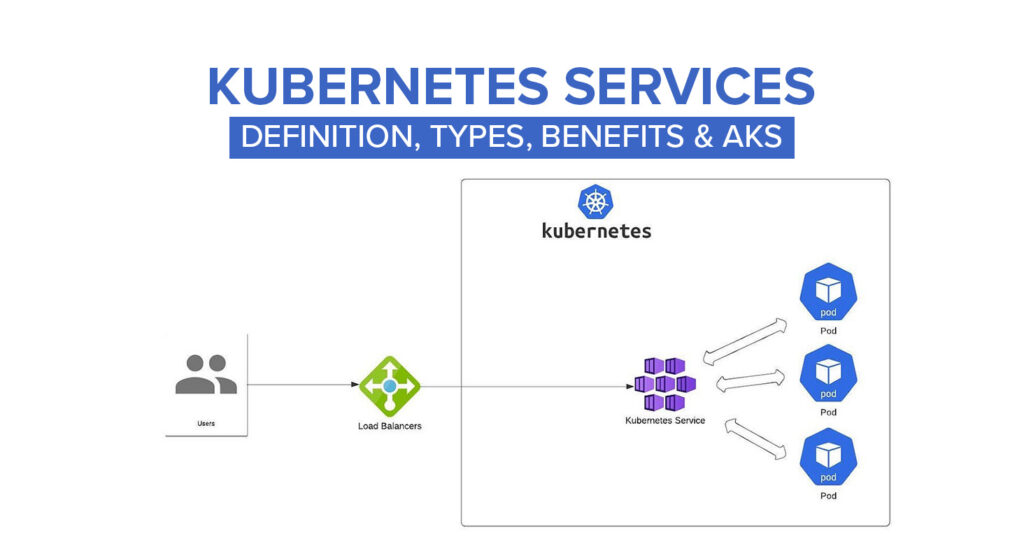Kubernetes Service: Definition, Types, Benefits & AKS

Kubernetes Service, an open-source container orchestration platform, has fundamentally transformed the deployment, management, and scaling of containerized applications. A critical aspect of Kubernetes’ efficacy lies in its sophisticated service architecture
Kubernetes Service acts as one of the fundamental concepts of Kubernetes paradigm and provides a uniform way to access and manage groups of Pods. This blog aims at discussing the Kubernetes Service in detail as far as their components, roles, and categories are concerned. Main components such as load balancing, service registration, as well as the access from externally is discussed. In addition, a comparison between service types is provided to explain the essences of these classifications and their application. This document sums up with the description about Azure Kubernetes Service (AKS) as a managed service and its ability to help in managing Kubernetes.
What is a Kubernetes Service?
A Kubernetes Service is an abstract of an object that holds a logical set of pods and a target policy for reaching them. kubernetes service types help in the connectivity of microservices, even if the pods creation and destruction occur frequently. It offers assignable reliable IP addresses and domain names to give secure networking inside the Kubernetes cluster.
What are the Components of a Kubernetes Service?
- Selector: Chooses the pods for the service targeting them by means of labels.
- Labels: Tags associated with pods for identification.
- Endpoints: Describes the target pods’ IP addresses and ports that are used by the targeted service.
- ClusterIP: The IP address within the cluster which should be used to access the service.
- Port Definitions: Describes the identification of the port through which the service will be run.
Why is it Necessary to Configure Kubernetes Service?
Configuring Kubernetes Service is crucial for several reasons:
- Load Balancing: Redistributes traffic across a number of pods in an edition making it highly reliable and available.
- Decoupling: Pulls the pod lifecycle off from the service lifecycle and lets them be scalloped and updated separately.
- Discoverability: Makes it possible to get pods in a constant manner regardless of the pod’s IP address.
- Network Policies: Aids in the execution of network security policies that may have been established.
What are the Types of Kubernetes Services?
There are 4 types of services in kubernetes available mentioned below:
- ClusterIP
ClusterIP is the default type of service in Kubernetes. It contains an internal IP address of the service in the cluster. It is mainly employed for messaging between services that are grouped in the same cluster.
Use Cases for ClusterIP
ClusterIP services are ideal for:
- Microservices Architecture: When there are different services that belong to the same cluster and thus require interacting with one another.
- Backend Communication: Like databases or internal API that should not be exposed externally.
- NodePort
NodePort displays the service on a fixed static port on the node’s IP address. This enables the flows from outside the system to reach the service using the node IP and the port defined here.
Use Cases for NodePort
NodePort services are suitable for:
- External Testing: Providing services for consumption only for the purpose of testing that is, outside the cluster.
- Limited External Access: Where webs are required to be accessed from outside but where there is no complexity of a load balancer.
- LoadBalancer
LoadBalancer makes an external load balancer in the cloud provider’s infrastructure and assign a fixed, external IP to the services. It forwards traffic to the pods of the service using the load balancer of the cloud provider.
Use Cases for LoadBalancer
LoadBalancer services are best for:
- Production Workloads: Where high availability and the scalability of the application are important parameters.
- Public-Facing Applications: As is the case with web applications that need a reliable and growing entry point.
- ExternalName
The ExternalName type maps a service to an external DNS name, which returns a CNAME record with the name. It enables references to services that are external to the Kubernetes cluster, for use by other Kubernetes service.
Use Cases for ExternalName
ExternalName services are useful for:
- External Dependencies: For a service that requires using the external API or service.
- Migration Scenarios: Where services are starting to be migrated to Kubernetes, and where external services are still used.
How Do Kubernetes Service Work?
Kubernetes Service works in a way that a certain number of pods must be identified using selectors. When a request is made to a service, Kubernetes describes how this request should be directed to one of the pods that fit that selector. Pod IP addresses are generalized, and have area service instead of being constantly changeable.
- Service Discovery
Kubernetes uses two primary methods for service discovery:
- Environment Variables: Passing environment information to the pods concerning the service to be delivered by the application.
- DNS: With the help of an internal DNS server, the service name is resolved with an IP address.
- Load Balancing
Kubernetes Service helps in load balancing as the traffic is spread evenly across the pods and these pods ensure the framework is highly available.
| Features | ClusterIP | NodePort | LoadBalancer | ExternalName | Headless Services |
|---|---|---|---|---|---|
| Accessibility | Internal | Internal and External | External | External | Internal |
| Use case | Internal communication | Exposing services to external | Managed external load balancing | Accessing external services | Direct access to pods |
| IP Type | Cluster wide | Node IP | External | External | None (uses pod IPs) |
| Complexity | Low | Medium | High | Low | Medium |
| Scalability | Easy to scale | Harder to manage for large scale | Scales with cloud infrastructure | Depends on external service | Directly scales with pods |
How is a Service Different from a Deployment in Kubernetes?
A Kubernetes Service is an abstraction for connecting to a set of pods and for providing IP, while a Deployment is liable for creating and operating these pods. Deployments are the responsibilities of creating, multiplying, and modifying pods, and Services are available for end-to-end connection to such pods.
Deployment Features:
- Replica Management: Ensures that the pod replicas are running in the correct count that is desired.
- Rolling Updates: Enables application upgrade without any interruption (zero downtime), Ensures easy scaling of applications and adding of features to the application.
- Rollback: Let’s have the functionality of rolling backs in instances that something goes wrong.
How to Create a Kubernetes Service?
To put it simply, to create a Kubernetes Service there should be a YAML file with the type of desired service, the selectors, and ports. Here’s an example of a ClusterIP service definition:
apiVersion: v1
kind: Service
metadata:
name: service
spec:
selector:
app: App
ports:
- protocol: TCP
port: 80
targetPort: 9376This YAML file specifies a service that targets pods with the label app: App the application that is bound on this container and it listens on port 80 within the internal network.
Steps to Create a Service
- Define the Service YAML: You should identify the service type, the selectors that you want to target, and the ports through which this service will work.
- Apply the YAML: Kubectl apply -f service. It generates the service of virtual hosts from the format of .ini, JSON and yaml.
- Verify the Service: To list and verify the created service, now it is time to run the command kubectl get services.
What is Azure Kubernetes Service?
Azure Kubernetes Service (AKS) is a managed Kubernetes service provided by Microsoft Azure. AKS simplifies the deployment, management, and operations of Kubernetes by offloading the responsibility of managing the Kubernetes control plane to Azure.
Key Features of AKS
Below are some of the azure kubernetes service mentioned:
- Managed Control Plane: They are used to manage and control the Kubernetes clusters, which also makes Azure manage the control plane so the actual management overhead is lowered.
- Integrated Azure Services: Fully integrated with other Microsoft Azure services such as; Azure Monitor, Azure Policy, and Azure Active Directory.
- Security: Inherent security controls in Azure like Azure Role-Based Access Control (Azure RBAC), Azure Virtual Network (AVN) policies, and Azure Defender.
- Scalability: Flexible in terms of scaling up the applications as well as the infrastructure in order to meet the demand.
Advantages of AKS
- Simplified Operations: Disburdens the control plane-management to Azure, so that team can solely focus on application development.
- Cost-Effective: Subscribe to the resources you need and for the managed control plane, no additional charges will be incurred.
- High Availability: High availability as built-in feature for applications guarantees that your applications will be up and running as needed.
- Developer Productivity: On the integration with CI/CD tools and services, we see improvements in terms of productivity amongst the developers.
Azure Kubernetes Service Benefits and Features
Benefits:
- Auto-Scaling: Dynamically brings up new nodes in the cluster to meet the amount of available resources required.
- Multi-Region Deployment: It offers support for deployment of applications across the multiple regions present in Azure for availability.
- Continuous Integration and Continuous Deployment (CI/CD): Works well with Azure DevOps and GitHub for CI/CD.
- Monitoring and Diagnostics: Specializes in providing additional monitoring and analysis functions with the help of the Azure Monitor and log analytics.
- Cost Management: Cost efficient measures like per second and reserved instances.
Features
- Azure Active Directory Integration: Helps to create highly developed identity and access management.
- Network Policies: Provides the flow of the network traffic within the cluster in a very much more effective way so that effective control is maintained.
- Azure Defender for Kubernetes: Has capabilities of threat detection and threat monitoring of Kubernetes infrastructure.
How DevTools Simplifies Cloud Infrastructure Security
Security in cloud infrastructure is made easier in Azure through tools and services that implement security standards, compliance enforcement as well as vulnerability identification. Azure security such as Azure Security Center, Azure Policy, and Azure Blueprint ensure security policies, compliance, and security of cloud solutions. DevTools leverages the Cloud services to implement the security standards and follow the best practices.
Key Security Tools
- Azure Security Center: A single pane of glass for security operations and; superior threat detection and prevention.
- Azure Policy: It allows the configuration of policies on readily usable and accessible resources in your Azure environment.
- Azure Blueprints: It helps to provide compliant and secure environments as per the templates set and made available to users.
Conclusion:
Kubernetes Service is core to running containerized applications as they offer reliable network connectivity, load balancing mechanisms, and the discovery of the service. It is relevant to recognize the categories of the services and their intended application due to the significant impact on design and scalability of Kubernetes applications. This is where Azure Kubernetes Service comes in as an improvement on the Kubernetes experience that provides a managed, scalable, and secure container host environment for running applications on the cloud. Thus, utilizing the capabilities of AKS can assist an organization in improving the efficiency of Kubernetes maintenance and devoting its primary efforts to creating value for customers through applications.




